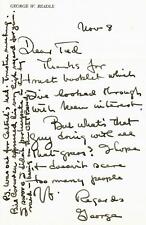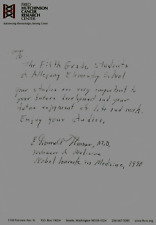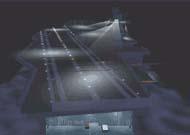
"Nobel Prize in Chemistry"Glenn Seaborg Signed 3X5 Card JG Autographs COA For Sale

When you click on links to various merchants on this site and make a purchase, this can result in this site earning a commission. Affiliate programs and affiliations include, but are not limited to, the eBay Partner Network.

"Nobel Prize in Chemistry"Glenn Seaborg Signed 3X5 Card JG Autographs COA:
$48.99
Up for sale the"Nobel Prize in Chemistry"Glenn Seaborg Hand Signed 3X5 Card.This item is certified authentic by JGAutographs and comes with their Letter of Authenticity. ES-6729E Glenn Theodore Seaborg(/ˈsiːbɔːrɡ/; April 19, 1912– February 25, 1999) was an American chemist whose involvement in thesynthesis, discovery and investigation of tentransuranium elementsearned him a share of the 1951Nobel Prize in Chemistry.His work in this area also led to his development of theactinide conceptand the arrangement of theactinideseries in theperiodic table of the elements. Seaborg spent most of his career as an educator and research scientist at theUniversity of California, Berkeley, serving as a professor, and, between 1958 and 1961, as the university's second chancellor.He advised tenUS Presidents– fromHarry S. TrumantoBill Clinton– on nuclear policy and was Chairman of theUnited States Atomic Energy Commissionfrom 1961 to 1971, where he pushed for commercialnuclear energyand the peaceful applications of nuclear science. Throughout his career, Seaborg worked for arms control. He was a signatory to theFranck Reportand contributed to theLimited Test Ban Treaty, theNuclear Non-Proliferation Treatyand theComprehensive Test Ban Treaty. He was a well-known advocate of science education and federal funding for pure research. Toward the end of theEisenhower administration, he was the principal author of the Seaborg Report on academic science, and, as a member of PresidentRonald Reagan'sNational Commission on Excellence in Education, he was a key contributor to its 1983 report "A Nation at Risk". Seaborg was the principal or co-discoverer of ten element 106, which, while he was still living, was namedseaborgiumin his honor. He also discovered more than 100 atomicisotopesand is credited with important contributions to the chemistry of plutonium, originally as part of theManhattan Projectwhere he developed the extraction process used to isolate the plutonium fuel for thesecond atomic bomb. Early in his career, he was a pioneer innuclear medicineand discovered isotopes of elements with important applications in the diagnosis and treatment of diseases, includingiodine-131, which is used in the treatment ofthyroiddisease. In addition to his theoretical work in the development of the actinide concept, which placed the actinide series beneath thelanthanideseries on the periodic table, he postulated the existence of super-heavy elements in thetransactinideandsuperactinideseries. After sharing the 1951 Nobel Prize in Chemistry withEdwin McMillan, he received approximately 50 honorary doctorates and numerous otherawards and honors. Thelist of things named after Seaborgranges from the chemical element Seaborgium to the asteroid4856 Seaborg. He was aprolific author, penning numerous books and 500 journal articles, often in collaboration with others. He was once listed in theGuinness Book of World Recordsas the person with the longest entry inWho's Who in America.

|
Other Related Items:
Related Items:
“Nobel Prize in Medicine" George Beadle Hand Written Letter COA $174.99

"Nobel Prize in Medicine" E. Donnall Thomas Hand Written Letter $279.99

"Nobel Prize in Medicine" Julius Axelrod Hand Album Page $209.99
| 


































